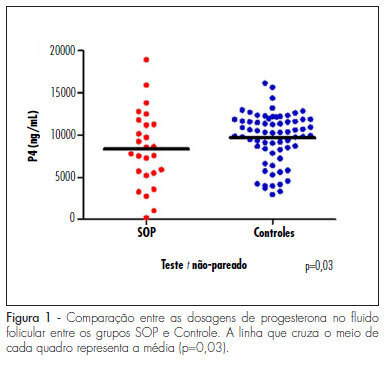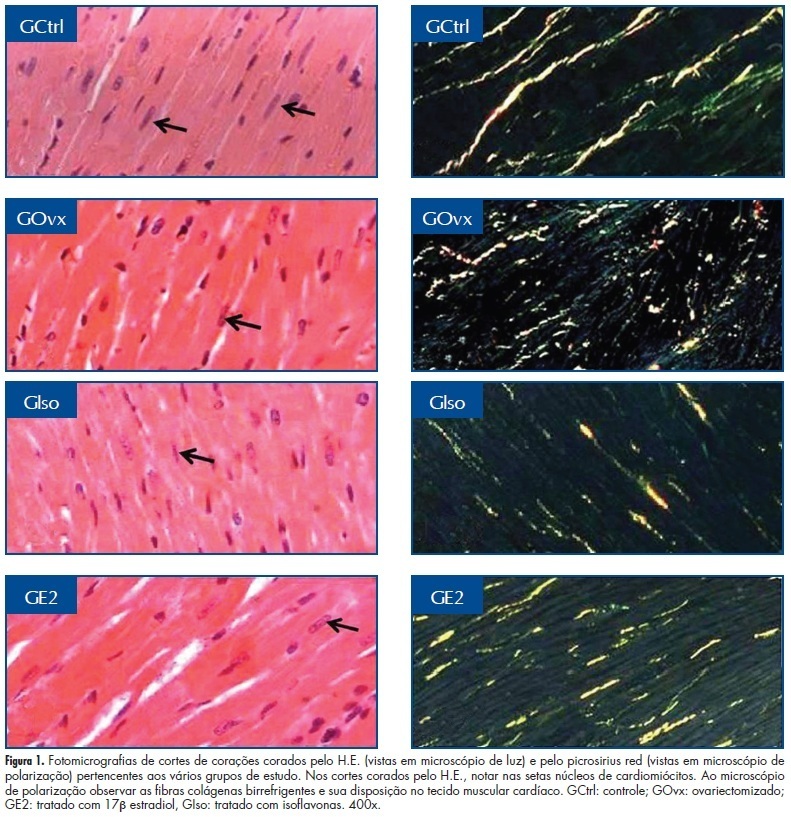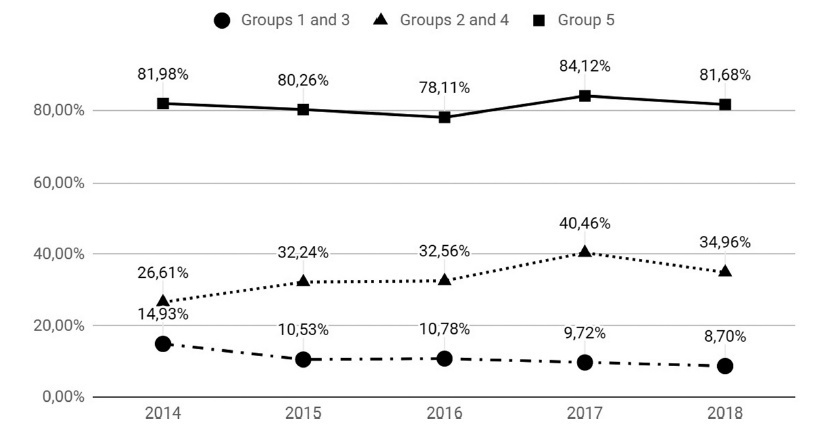Summary
Revista Brasileira de Ginecologia e Obstetrícia. 2010;32(9):447-453
DOI 10.1590/S0100-72032010000900006
PURPOSE: to evaluate the concentration of steroid hormones in follicular fluid (FF) of small (10-14 mm) and large (> 18 mm) follicles of women with polycystic ovary syndrome (PCOS) submitted to controlled ovarian hyperstimulation (COH) and in vitro fertilization (IVF) cycles. METHODS: a case-control study was conducted on 13 infertile women with PCOS (17 cycles) and 31 infertile women due to male factor - Control Group (31 cycles). FF was aspirated individually and divided into four groups: G1 (FF of small follicles of the Control Group), G2 (FF of small follicles of the PCOS group), G3 (FF of large follicles of the Control Group) and G4 (FF of large follicles of the PCOS group). Estrogen, progesterone and β-hCG were determined by chemiluminescence, and testosterone and androstenedione by radioimmunoassay. The unpaired t-test was used to compare the hormone determinations in the FF of the PCOS and Control Groups, and the four groups were compared by ANOVA. Fisher's exact test was used to compare the pregnancy rates. RESULTS: the small follicles of the two groups had lower progesterone levels (8,435±3,305 ng/mL) than large follicles (10,280±3,475 ng/mL), p-value <0.01. The progesterone levels of all follicles of group PCOS (8,095±4,151 ng/mL) were lower than Control (9,824±3,128 ng/mL), p-value =0.03. Testosterone differed between G1 (326.6±124.4 ng/dL) and G3 (205.8±98.91 ng/dL), p-value <0.001, and between G3 (205.8±98.91 ng/dL) and G4 (351.10±122.1ng/dL), p-value <0.001. Small follicles had higher testosterone levels (508.9±266 ng/dL) than large follicles (245.10±123 ng/dL), p-value <0.0001. The pregnancy rates did not differ between the PCOS (5/13, 38.5%) and the Control groups (9/31, 40.9%), p-value =072. CONCLUSIONS: women with PCOS had high testosterone concentrations in the FF, regardless of the stage of follicle development, and reduced progesterone levels, suggesting that paracrine factors may inhibit the secretion of the latter by follicular cells. The pregnancy rates showed that treatment with COH and IVF is a good option for women with infertility secondary to PCOS.

Summary
Revista Brasileira de Ginecologia e Obstetrícia. 2009;31(9):447-452
DOI 10.1590/S0100-72032009000900005
PURPOSE: to compare the effects of functional electrostimulation of the pelvic floor and therapy with cones in women with stress urinary incontinence (SUI). METHODS: randomized clinical study for which 45 patients with SUI were selected. The effects of functional electrostimulation of the pelvic floor were evaluated in the SUI treatment of 24 women, with the use of clinical data (micturition diary, pad test and a questionnaire about quality of life - I-QoL). The patients were submitted to two 20' weekly sessions for four consecutive months, under the supervision of a physiotherapist. The electrode used had 10 cm length and 3.5 cm width with a double metallic ring and a cylindrical shape, positioned in the medium third of the vagina. The electric parameters used were: intensity varying from 10 to 100 mA and 50 Hz of fixed frequency, with pulse duration of 1 ms. Also, we evaluated 21 patients who were submitted to vaginal cone treatment. The cone therapy was done with two 45 minute sessions per week. The cones' weight varied from 20 to 100 gr. RESULTS: there was no difference between the outcomes of electrostimulation of the pelvic floor and the vaginal cones for the treatment of SUI (p>0.05). After four months, there was a significant improvement in the I-QoL index of the patients treated both with electrostimulation (40.3 versus 82.9) or with the cones (47.7 versus 84.1). There was a significant decrease in pad weight in both groups, measured before and after the treatment (28.5 and 32 g versus 2.0 and 3.0 g for the electrostimulation and cone group, respectively). Finally, there was a significant decrease in the number of urinary leakage evaluated by the micturition diary in both groups (p<0.0001). CONCLUSIONS: both electrostimulation and vaginal cones were effective in the treatment of women with SUI.
Summary
Revista Brasileira de Ginecologia e Obstetrícia. 2013;35(10):447-452
DOI 10.1590/S0100-72032013001000004
PURPOSE: To analyze prenatal care in public and private services. METHODS: A cross-sectional, retrospective and analytic study was conducted based on the audit of files of pregnant women who had given birth at a reference hospital for low risk cases in the area of Campos Gerais - Paraná State, in the first semester of 2011. The Yates chi-squared test or exact Fisher test were used to determine the association between the lack of registration files for pregnant women regarding prenatal assistance in the public and private services, with the level of significance set at p≤0.05. The quality of prenatal care was determined based on the percentile of non-registrations. RESULTS: A total of 500 prenatal files were analyzed. There was a significant attendance of six or more prenatal visits, with a larger proportion in the private service (91.9%). The laboratory and obstetric exams most frequently not registered in the public and in the private services were, respectively: hepatitis B (79.3 and 48.4%), hemoglobin and hematocrit values (35.6 and 21.8%), anti-HIV serology (29.3 and 12.9%), fetal movement (84.3 and 58.9%) and length (60.4 and 88.7%), edema verification (60.9 and 54.8%), and fetal presentation (52.4 and 61.3%). The audit of the files of pregnant women allowed to determine the quality of the prenatal care provided and confirmed differences in assistance according to the place, showing excellent and good quality of private care, and regular public care for ultrasonography and blood type/Rh factor; regular quality of private care and poor quality of public care for urine tests and weight. For the other types of laboratory and obstetric exams and vaccines, the quality was poor or very poor in both types of services. CONCLUSION: The differences between the services showed that there is a need for actions aiming at the improvement of the prenatal care provided by public services.
Summary
Revista Brasileira de Ginecologia e Obstetrícia. 2012;34(10):447-452
DOI 10.1590/S0100-72032012001000003
PURPOSES: To evaluate the histomorphometry of cardiomyocytes and collagen present in the myocardium of rats treated with a concentrated extract of soy or 17β-estradiol (E2). METHODS: Twenty-eight rats were divided into four groups: GCtrl - estrus phase; GOvx - ovariectomized (Ovx) and receiving vehicle; GIso - Ovx and treated with soy extract (150 mg/kg per day); GE2 - Ovx and treated with E2 (10 µg/kg per day). The drugs and vehicle (0.2 mL propylene glycol) were administered for 30 consecutive days after ovariectomy. On the last day the animals were anesthetized, the hearts removed, submerged in 10% formaldehyde and fragments of the ventricles underwent histological procedures, and the sections were stained with hematoxylin and eosin or picrosirius-red. Histomorphometric analysis (number and volume of nuclei and quantification of collagen) was performed under a light microscope with AxioVision Rel. 4.2 software, and collagen fibers were quantified using IMAGELAB-2000 software. Data were submitted to ANOVA followed by the Tukey test (p<0.05). RESULTS: We observed a higher number of cardiomyocyte nuclei in animals of the Ovx and Iso groups than in GE2 and GCtrl animals (GOvx=121.7±20.2=GIso=92.8±15.4>GE2=70.5±14,8=GCtrl=66.3±9.6; p <0.05), while the nuclear volume was greater in the Ctrl and E2 groups (GE2=35.7±4.8 GCtrl=29.9±3.6=>GIso=26.5±4.5=GOvx=22.4±2.9; p <0.05). Collagen concentration was higher in the Ovx group (GOvx=5.4±0.1>GCtrl=4.0±0.1=GIso=4.4±0.08=GE2=4.3±0.5; p <0.05). CONCLUSIONS: Estrogen may prevent the reduction of the nuclear volume of cardiomyocytes and collagen deposition between heart muscle fibers, while the administration of isoflavones only prevents the deposition of collagen, which can preserve the mechanical properties of cardiac fibers.

Summary
Revista Brasileira de Ginecologia e Obstetrícia. 2002;24(7):447-452
DOI 10.1590/S0100-72032002000700004
Purpose: to compare the size of locally advanced breast tumors through clinical examination, mammography, and ultrasound, and describe the parameters of color Doppler ultrasound evaluated before and after primary chemotherapy. Methods: it was a prospective and descriptive clinical study. Eighteen women with the diagnosis of breast carcinoma, with clinical primary tumors of 50 mm or larger, were submitted to palpation, mammography, ultrasound and color Doppler ultrasound at the moment of diagnosis and after 3 cycles of chemotherapy. The response was considered present when there was a clinical decrease of 50% or more and an ultrasonographic decrease of 25% or more, and absent when there was a clinical decrease less than 50% and ultrasonographic decrease less than 25%. A descriptive statistical analysis and Wilcoxon test were used. Results: regarding the size of the tumors, the method whose results were closer to pathological examination was the clinical examination after chemotherapy, when compared with sizes on ultrasound and mammography. The mammography helped to evaluate 44% of the cases before chemotherapy (8/18). In the cases where the response was absent, the Doppler showed a significant increase of the flow and a decrease of resistance and pulsatility index. In the cases where the response was present (9 cases), the Doppler did not show any significant change regarding the studied parameters. Conclusion: clinical examination was the most efficient method to evaluate the decrease of the volume of tumors submitted to neoadjuvant chemotherapy when compared with ultrasound and mammographic examinations. Doppler showed increase of the flow in the cases of absent response.
Summary
Revista Brasileira de Ginecologia e Obstetrícia. 1999;21(8):447-449
DOI 10.1590/S0100-72031999000800004
SUMMARY Purpose: the number of male sexual partners, age, precocious beginning of sexual activity, cigarette smoking and oral contraception were correlated with human papillomavirus (HPV) infection, as were cervical ectopia, although with conflicting results. The objective is to analyze a group of women with HPV infection and to verify the incidence of cervical ectopia. Methods: we have studied 471 women with Papanicolaou smears suggesting HPV infection (Schneider et al.'s criteria) and its relationship with cervical ectopia, beginning of sexual activity and the use of oral contraceptive. Results: of the total of cases, 182 (38.6%) had ectopia. Of these, 157 (86.3%) were 30 years old or less, compared to 47.8% of women without ectopia (p<0.001, chi² test). A percentage of 77.4 of cases with ectopia had the beginning of sexual activity before 18 years compared to 71.3% cases without ectopia. Among women with ectopia, 45.7% had taken the pill recently compared to 24.3% which had not (p<0.001, chi² test). Conclusions: it was concluded that the beginning of sexual activity was not correlated with ectopia. The prevalence of ectopia was more commom in women under 30 years and/or in use of oral contraceptive.
Summary
Revista Brasileira de Ginecologia e Obstetrícia. 2023;45(8):447-455
Women play an essential role in maintaining the family's health, and family planning is part of women's and families' health. The couple's mutual understanding of family planning methods is essential in selecting contraception. Acceptance of and satisfaction with different contraception methods can impact sexual satisfaction. The present study aimed to compare the effect of the information-motivation-behavioral (IMB) model and psychoeducational counseling on sexual satisfaction and contraception methods of women referring to health centers in Kerman.
This trial was conducted on 81 women aged 18 to 45, in Kerman health centers, from 2021 to 2022. Participants were randomly divided into 3 groups of 27 people (control, psychoeducational counseling, and IMB method). Three online counseling sessions were held for the psychoeducational group, and four were held for the IMB group. The control group received routine care. The IBM SPSS Statistics for Windows, version 22 (IBM Corp. Armonk, NY, USA) was used for data analysis using nonparametric Friedman and Kruskal-Wallis tests.
The mean age of participants was 32.59 ± 7.04, and the majority of them had university degrees and were homemakers. The mean sexual satisfaction score significantly increased immediately after the intervention and 1 month later in the 2 interventional groups (p < 0.0). Changes in contraception methods after intervention were significant in the psychoeducational group (p = 0.0)
The results indicate the positive impact of psychological counseling on women's sexual satisfaction and contraception method. The IMB method also impacted men's sexual satisfaction but did not lead to any changes in the contraceptive method.
Summary
Revista Brasileira de Ginecologia e Obstetrícia. 2020;42(8):448-453
To analyze the rates of cesarean delivery longitudinally in a university hospital using the Robson classification.
Data related to births performed between 2014 and 2018 and recorded in the Maternal and Neonatal Health Information System (Sistema de Informações em Saúde Materna e Neonatal, SISMATER, in Portuguese) were analyzed using the Robson classification. As an aid, we used articles published in the last five years that approach the same topic in other Brazilian maternity hospitals; they were retrieved from the LILACS, MEDLINE, CINAHL, Scopus, Web of Science and Cochrane Library databases.
There was little variation in the total rate of cesarean sections in the period; however, the profile of each group changed over the years. It was possible to verify a significant reduction in the participation of groups of pregnant women with lower risk and an increase in high-risk pregnancies, attributable to the decrease in beds in the institution, with a greater transfer of patients. In addition, there was a reduction in cesarean sections among the lower-risk groups,while the rate among the higher-risk groups remained stable.
The use of the Robson classification to stratify cesarean deliveries contributes to a better analysis of the indications for cesarean delivery, enabling the establishment of strategies to reduce the rates, generating a positive impact on hospital management and quality of care.
